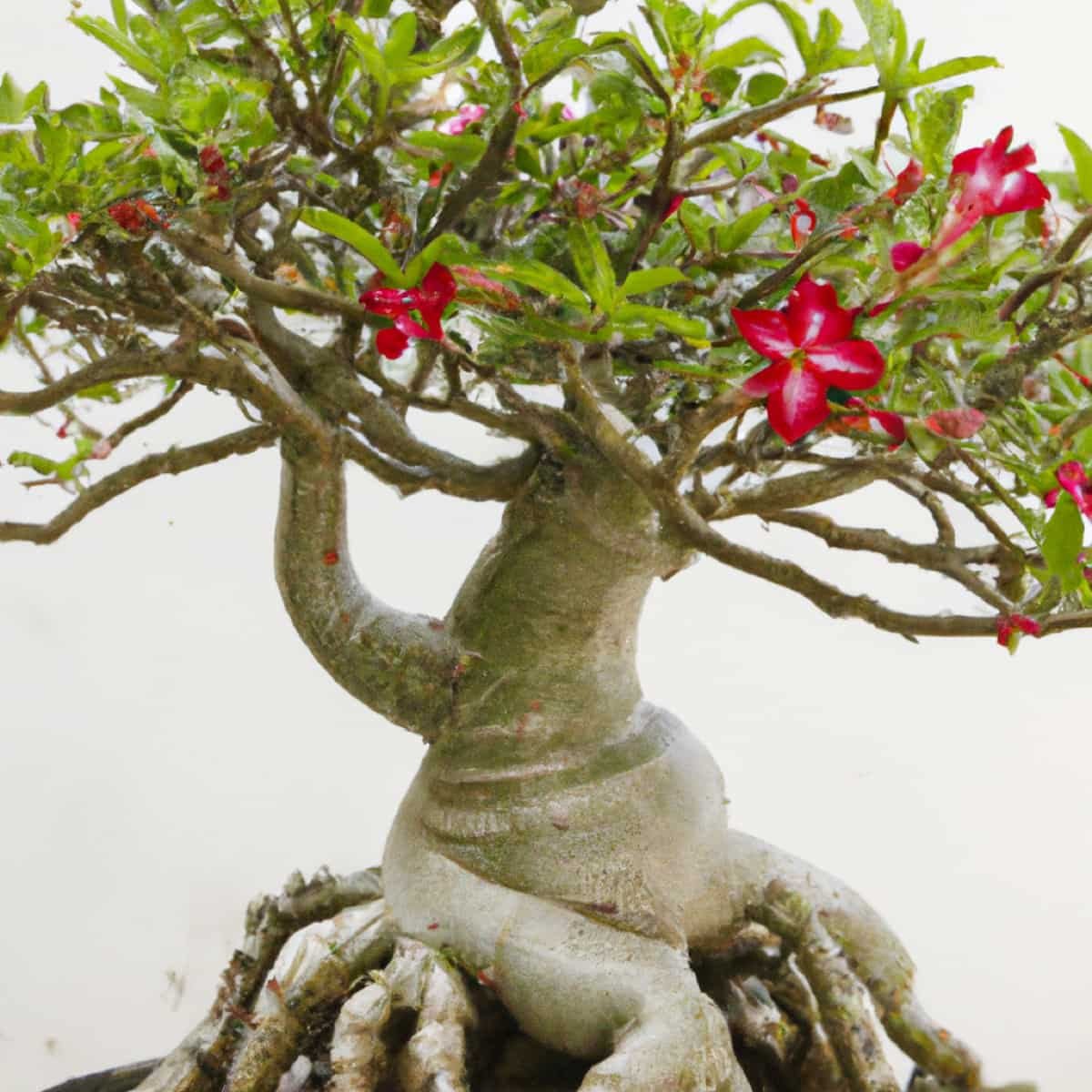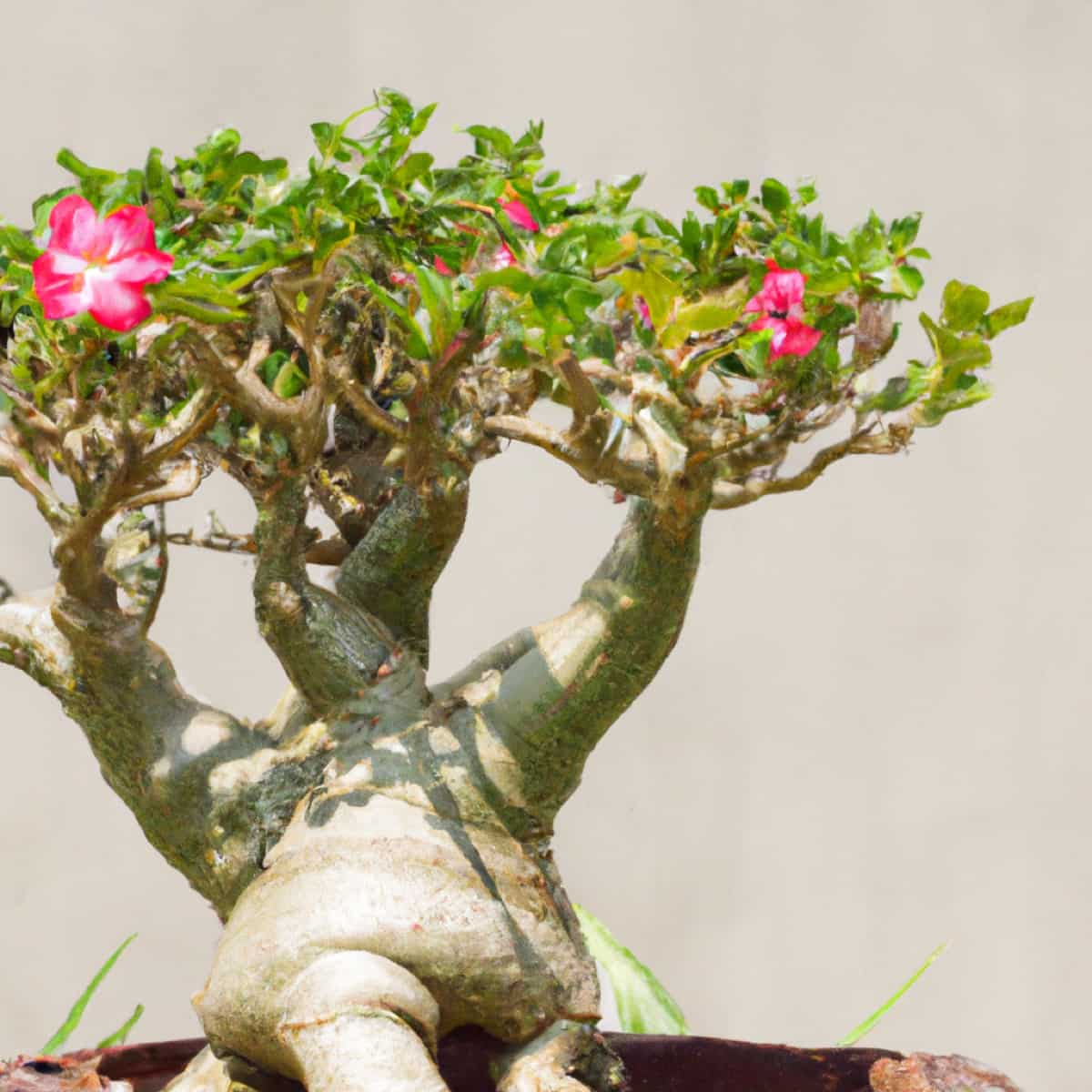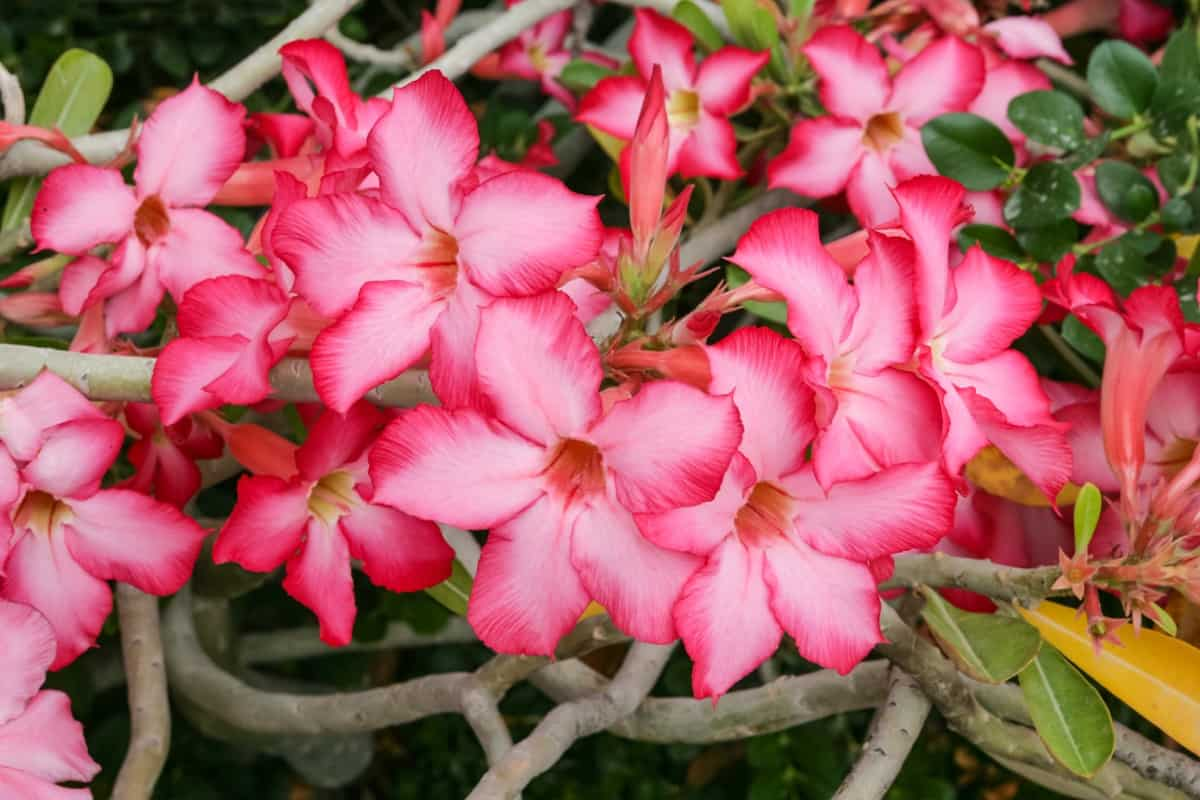The Desert Rose Bonsai is a fascinating and beautiful ornamental plant known for its stunning blossoms and unique bulbous base. A notable characteristic of this plant is its striking resemblance to a miniature tree, thus making it a perfect candidate for bonsai cultivation. The art of nurturing a Desert Rose Bonsai from seed to a full-grown tree provides a rewarding experience and an array of benefits.

It’s a therapeutic hobby, can be a splendid décor piece, and has air-purifying qualities when kept indoors. Whether starting from scratch with a Desert Rose Bonsai grow kit or pruning a mature bonsai to maintain its size and shape, these tips will guide you through growing and caring for your Desert Rose Bonsai.
How to Grow and Care for Desert Rose Bonsai
How to Plant Desert Rose Bonsai From Seeds
Planting a Desert Rose Bonsai from seed is a delightful and fulfilling task. First, a seed tray filled with light and well-draining soil mix is needed. Distribute the seeds evenly across the area and delicately place a thin soil layer over them. Next, water the tray gently to avoid displacing the seeds.
Once you’ve completed these steps, place the tray in a warm, bright, and well-ventilated spot. A sunny windowsill is an ideal location for this. Germination should occur within one to two weeks. Once your seedlings reach a height of about two to three inches and have developed a couple of true leaves, they are ready to be transplanted into individual pots.
Tips for Growing Desert Rose Bonsai Indoors
Cultivating a Desert Rose Bonsai indoors is a perfect way to brighten any living space while enjoying its benefits. Here are some essential tips for healthy growth. Optimal sunlight is crucial for your bonsai’s well-being. Ensure you place it in a well-lit area, ideally near a south-facing window.
Desert Roses thrive in full sun conditions. Additionally, try to maintain an indoor temperature of around 60-90°F, replicating their natural desert environment. Use light and well-draining soil mix and avoid over-watering. Ensure thorough drying of the soil prior to subsequent watering.
In case you missed it: How to Grow and Care for Calamondin Orange Bonsai: Planting, Pruning, and Repotting

Best Soil Mix for Desert Rose Bonsai
One of the secrets to a thriving Desert Rose Bonsai is the right soil mix. This plant prefers a well-draining, gritty soil mix to prevent root rot. Cactus potting soil, coarse sand, and perlite blend work well. The cactus soil provides necessary nutrients, the sand improves drainage, and the perlite aerates the soil, encouraging root growth. It’s crucial that the soil mix remains light and doesn’t compact over time, as this could potentially cause root suffocation.
Watering Schedule for Desert Rose Bonsai
The watering schedule for a Desert Rose Bonsai is crucial. It’s susceptible to root rot if over-watered, which could lead to your bonsai’s demise. As a succulent, this plant can tolerate dry periods. It’s best to let the soil dry out completely between watering. When you water, do so thoroughly, allowing excess water to drain. Remember, it’s better to be underwater than overwater. Minimize irrigation during the dormant period in winter.
Pruning Techniques for Desert Rose Bonsai
Pruning is a critical aspect of maintaining a Desert Rose Bonsai. Regular Desert Rose Bonsai pruning ensures the plant maintains its miniature size, promotes bushier growth, and helps shape it into an attractive form. The best time for pruning is during active growth, generally in spring or early summer.
Remove any dead or diseased branches first. Then, using sharp, sterilized shears, prune back long, unruly branches to maintain the shape of the bonsai. Remember that cuts should be made just above a leaf node or branch to encourage new growth in that direction.
Protecting Desert Rose Bonsai From Pests and Diseases
A healthy Desert Rose Bonsai can be quite resilient but is still susceptible to pests and diseases. The most common threats are mealybugs, aphids, and root rot. Keep your bonsai healthy by regularly inspecting it for signs of pests and diseases. If you spot pests, remove them manually or use a mild insecticidal soap. As for diseases, root rot caused by overwatering is the most common. To prevent this, adhere to a consistent watering regimen and utilize a soil mixture that allows for effective drainage.
Repotting Desert Rose Bonsai
Repotting a Desert Rose Bonsai is necessary for its health and growth. This process is typically performed every two to three years or whenever the bonsai outgrows its pot. Spring is the optimal season for transplanting since it coincides with the plant’s vigorous growth period. Use a pot only slightly larger than the root ball to prevent waterlogged soil, which could cause root rot. A well-draining soil mix is essential. Once repotted, water thoroughly and place your bonsai in a bright location.
In case you missed it: How to Grow and Care for Persimmon Bonsai: Planting, Pruning, and Repotting

Fertilizing Requirements for Desert Rose Bonsai
Fertilizing is essential for the overall health and vitality of your Desert Rose Bonsai. A balanced liquid fertilizer is suitable for this plant. It’s best to fertilize every two weeks during the active growing season (spring to early fall). Reduce the frequency or stop entirely during winter when the plant is dormant. Remember to water your bonsai thoroughly before applying fertilizer to avoid root burn.
Training and Shaping Desert Rose Bonsai
Training and shaping your Desert Rose Bonsai is key to bonsai cultivation. This art form aims to mimic the shape of mature trees in nature. To achieve this, wiring techniques are used. Select the branches you wish to shape and apply a wire of suitable thickness around them. Gently bend the wired branches to your desired position. Monitor your bonsai regularly to ensure the wire does not dig into the growing branches.
Winter Care for Desert Rose Bonsai
During winter, the Desert Rose Bonsai enters a period of dormancy. It requires less watering during this time and should be kept in a warm environment. If temperatures drop below 50°F, moving the bonsai indoors is best to protect it from the cold. The plant also requires less light during this period but should still be kept in a bright location. Cut back on fertilizing, resuming only when new growth appears in spring.
In case you missed it: How to Grow and Care for Fig Bonsai: Planting, Repotting, and Pruning

Conclusion
Caring for a Desert Rose Bonsai can be a deeply rewarding journey, filled with lessons in patience, attentiveness, and the intricate beauty of nature. This bonsai possesses distinctive qualities that can greatly enhance both indoor and outdoor environments, whether it is nurtured from a seedling or carefully crafted from a mature tree.
From the careful art of pruning to protecting your plant from pests and diseases, each step requires a keen eye and delicate touch. But the outcome – a beautifully sculpted Desert Rose Bonsai, basking in the winter sun or bursting with vibrant blooms – is a sight to behold. Every Desert Rose Bonsai is a testament to the resilient beauty of nature and the rewarding art of bonsai cultivation.